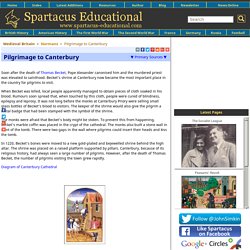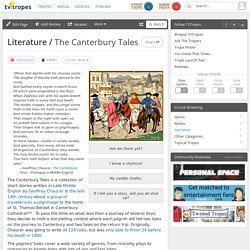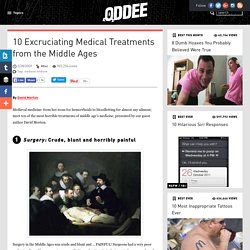

Pilgrimage to Canterbury. Soon after the death of Thomas Becket, Pope Alexander canonised him and the murdered priest was elevated to sainthood.

Becket's shrine at Canterbury now became the most important place in the country for pilgrims to visit. When Becket was killed, local people apparently managed to obtain pieces of cloth soaked in his blood. Rumours soon spread that, when touched by this cloth, people were cured of blindness, epilepsy and leprosy. It was not long before the monks at Canterbury Priory were selling small glass bottles of Becket's blood to visitors. Geoffrey Chaucer - Author, Poet. English poet Geoffrey Chaucer wrote the unfinished work, The Canterbury Tales.

It is considered one of the greatest poetic works in English. Synopsis Poet Geoffrey Chaucer was born circa 1340 in London, England. In 1357 he became a public servant to Countess Elizabeth of Ulster and continued in that capacity with the British court throughout his lifetime. The Canterbury Tales became his best known and most acclaimed work. Early Life. The Canterbury Tales (Literature) Are we there yet?

I know a shortcut! My saddle chafes. If I tell you a story, will you all shut up? "Whan that Aprille with his shoures soote, The droghte of Marche hath perced to the roote, And bathed every veyne in swich licour, Of which vertu engendred is the flour; Whan Zephirus eek with his swete breeth Inspired hath in every holt and heeth The tendre croppes, and the yonge sonne Hath in the Ram his halfe cours y-ronne And smale fowles maken melodye, That slepen al the night with open ye, So priketh hem nature in hir corages: Than longen folk to goon on pilgrimages, And palmers for to seken straunge strondes, To ferne halwes, couthe in sondry londes; And specially, from every shires ende Of Engelond, to Caunterbury they wende, The holy blisful martir for to seke, That hem hath holpen, whan that they were seke. " Abhorrent Admirer: The "loathly lady" in the Wife of Bath's Tale. And then they all ate the Nun's Priest. Geoffrey Chaucer - Author, Poet.
English poet Geoffrey Chaucer wrote the unfinished work, The Canterbury Tales.

It is considered one of the greatest poetic works in English. Synopsis Poet Geoffrey Chaucer was born circa 1340 in London, England. In 1357 he became a public servant to Countess Elizabeth of Ulster and continued in that capacity with the British court throughout his lifetime. The Canterbury Tales became his best known and most acclaimed work. Early Life Poet Geoffrey Chaucer was born circa 1340, most likely at his parents’ house on Thames Street in London, England. Geoffrey Chaucer is believed to have attended the St. InTech The history of cataract surgery. 10 Excruciating Medical Treatments from the Middle Ages (medieval medicine) By David Morton Medieval medicine: from hot irons for hemorrhoids to bloodletting for almost any ailment; meet ten of the most horrible treatments of middle age's medicine, presented by our guest author David Morton.

Surgery: Crude, blunt and horribly painful Surgery in the Middle Ages was crude and blunt and … PAINFUL! Surgeons had a very poor understanding of human anatomy, anesthetics and antiseptic techniques to keep wounds and incisions from infection. It was not a pleasant time to be a patient, but if you valued your life, there was no choice. But there were some great successes. Dwale: A crude anesthetic that could cause death in itself Surgery in the Middle Ages was really only used in life/death circumstances.
The Middle English word used to describe an anesthetic potion was "dwale" (pronounced dwaluh). The hemlock juice alone could easily have caused death. Medscape: Medscape Access. Vampirism in the Middle Ages. History of vampire lore Most cultures around the world have tales of vampires.

Though they may differ in appearance, behavior and name, all are dark creatures who feed off the blood or essence of humans. The term vampire first appeared in the English language in the 1700s, and came into common use a few centuries later, due in large part to a rise of popular vampire fiction. However, other cultures mentioned similar creatures perhaps as early as the 2nd century. According to Lindahl, McNamara, and Lindow’s “Medieval Folklore” encyclopedia, part of Homer’s Odyssey, which was written in the 8th century B.C.E., contains a tale of a transfusion of living blood giving life back to the deceased. Vampire Superstitions. "Ah, but hear me through.

He can do all these things, yet he is not free. Nay, he is even more prisoner than the slave of the galley, than the madman in his cell. He cannot go where he lists; he who is not of nature has yet to obey some of nature's laws. Tony Robinson on the top five superstitions that gripped medieval Britain. Ancient Britons didn’t despatch people willy-nilly, but in times of crisis – if a whole community was rocked by plague, say – then they might decide to sacrifice somebody as a way of bartering with the gods. In some cases, a wicker pyre in the shape of a man would be stuffed with animals and even human offerings. We can trace this practice back to Celtic times. The Middle Ages: Feudal Life.